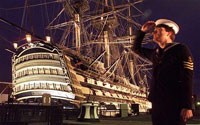 A disturbing report published yesterday in the Telegraph.
A disturbing report published yesterday in the Telegraph.
HMS Victory rotting and being pulled apart under its own weight
HMS Victory is riddled with rot and being pulled apart by its own weight, maintenance reports of the historic ship have found.
As Britain’s most celebrated warship, she withstood the onslaught of the combined French and Spanish navies at the Battle of Trafalgar. But HMS Victory, the flagship of Lord Nelson, now faces its ultimate battle.
The 245-year-old ship is leaking, is riddled with rot and is gradually being pulled apart by its own weight, according to maintenance documents and a structural survey obtained by The Sunday Telegraph.
Much-needed repairs have not been carried out and previous renovation work may have even damaged the HMS Victory’s structural integrity.

Check the link for ‘HMS Victory rotting and being pulled apart under its own weight’ the url is in the link twice.
Best,
Fred
Thanks for catching that. I fixed it.
Pingback: Restoration work for HMS Victory : Old Salt Blog – a virtual port of call for all those who love the sea
Thought you may be interested in this response from Jonathan Coad.Chairman, Victory Advisory Technical Committee:-
HMS Victory
The recent article in the Sunday Telegraph on the condition of HMS Victory may have led to some alarm and it is perhaps helpful to set out the Society’s long involvement with Nelson’s flagship. It is well known that the Society played key roles in saving her, securing a permanent berth in Portsmouth Naval Base and in her immediate restoration undertaken in the 1920s. The pioneering days of involvement with Victory may be long gone, but it is perhaps less apparent that she needs our continuing support more than ever before. Much specialist help and advice comes from individual members of the SNR directly involved with the ship and with the Save the Victory Fund that is administered by the Society.
In 1922 the Admiralty agreed to provide Victory with a permanent berth in 2 Dock, to retain her as a ship in commission and to take responsibility for repairing and maintaining her hull. All other restoration work per se and her fitting out would have to be privately funded. The SNR organised the fund-raising appeal that by 1925 had raised some £80,000. The STVF plays an absolutely crucial role with the ship and over the last couple of decades has channelled the best part of a million pounds into her, enabling the ship’s curator to transform her appearance, bringing her back to more of her Trafalgar appearance. This work is far from finished.
Members of the SNR make valuable and varied contributions to the Victory Advisory Technical Committee and to its Interpretation Sub-Committee. The VATC was originally set up in 1929 to advise the Board of Admiralty on the conservation and display of the ship and Admiralty rules forbid a member of MOD from holding its chairmanship. Both I and my distinguished predecessor as Chairman of the VATC have contributed part of the SNR interest. Chairman have a valued right of direct access to Second Sea Lord and through him to the Board of Admiralty.
It is important to remember that the VATC is an advisory body, but in practice its advice is rarely ignored, although financial constraints mean that actions are not always as speedy as might be wished. There are also inevitably some grey areas of funding where it is not immediately apparent who is financially responsible. This has never been seen as a problem and the STVF has worked in partnership with MOD, for example contributing from time to time funds for cordage and for blocks, enabling the ship to be displayed in a full-rigged condition rather than simply with standing rigging.
The article in the Sunday Telegraph appears to have been largely based on information in the draft Conservation Management Plan for the ship. It does not reveal any problems that are not already known to the VATC, but in the way of such articles it casts some of these in an overly-alarmist light. The VATC is confident that, provided her projected funding remains in place, the on-going maintenance and conservation programme for Victory will ensure her well-being
for the future. At the same time, it must be appreciated that she is now approaching 252 years old, far beyond her design life, and her need for a continuing high level of maintenance and conservation will not diminish.
The draft Conservation Management Plan for the ship is a welcome MOD initiative as it brings the ship into line with best conservation practice. The Interpretation Sub-Committee and the Ship’s Curator have been working on a parallel document setting out research priorities for the ship for the next 10-20 years. Taken together these documents should provide long-term guidance and priorities for the conservation and display of Victory.
The CMP was commissioned ahead of the banking crisis and it would be idle to pretend there are no funding problems. However, it is less than two years since MOD stated that there were no plans to change the status of the ship and that she would be retained in commission and her repairs fully funded. This remains by far and away the best course to secure her future. The SNR supports this approach and is pressing for adequate and timely money and skilled staff to be provided for conservation. Part of Victory’s sense of place in our national history stems from her remaining a commissioned ship of the Royal Navy. If she ceased to be this and became a purely a commercial venture she would be subjected to a host of new pressures that would not necessarily be of benefit to her conservation or sense of place.
Jonathan Coad.
Chairman, Victory Advisory Technical Committee.
January 2011.
http://www.snr.org.uk/news/Victory_conservation.pdf